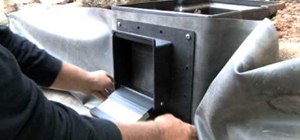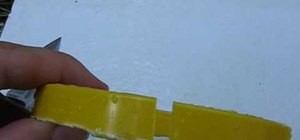Most bamboo in the United States is running bamboo, because nearly all cold hardy bamboo is the running or invasive type. The tropical bamboos are mostly "clumpers" and stay in a nice, tight clump. Running bamboos spread far and wide and can be very invasive. I grow many kinds of running bamboos and over the past 20 years I've had to learn how to control it's spread.
Since bamboo can spread underground as much as 30 feet or more each season, it's a good idea to plan just how you will control it once you plant it. The key to control is knowing a little about how it spreads. The bamboo grove sends out underground rhizomes in late summer and fall. If you stop or deflect these rhizomes, you can control the bamboo's spread.

I recently pulled up the rhizomes above. They were from a young grove and had grown about 12 feet during late summer.
Step 1 Mowing
The easiest way to control running bamboo is to simply kick over or mow new shoots when they come up in the spring. These type of bamboos only shoot in the spring. Once the shooting season is over, the bamboo will stop trying to send up shoots until the next spring. This works fairly well but you will have a network of rhizomes just below the surface of the ground and more and more shoots each spring. There is a large grove of Arrow bamboo (P. japonica) near my home with a fence on one side. The neighbor has a lawn and keeps it mowed up to the fence. Each spring there are literally hundreds of new shoots coming up in his yard, up to 25 feet or more from the grove. As they grow so fast they will be up to a foot or more high in just a day or two. Left alone they would form a dense grove of bamboo, 15 to 18 feet high in just a few weeks time. That's why regular mowing is so necessary. But again, just in spring and early summer.
The rhizomes also sometimes come out of the ground and dive back down leaving a small arch shaped piece of rhizome that is easy to trip over. These are very tender, but as they age a little, become extremely tough and can only be cut with a saw, pruning shears or axe, so it's best to cut them when you first see them. Once they toughen up, they can be very tough on a lawn mower.
Step 2 Rhizome barrier
A common way to control running bamboo is using rhizome barrier. This is a tough, flexible plastic that is installed in the ground, completely surrounding the bamboo. It comes in various thicknesses and widths, but at a minimum I would use 24" wide and perhaps 36" in sandy soil. The barrier must be installed with a couple inches above ground because the rhizomes can emerge from the ground and "jump" the barrier. You will need to inspect the barrier each year and cut any rhizomes that have crossed it.
There are many suppliers online with a search for "rhizome barrier". A large manufacturer with many distributors is DeepRoot. The success of the barrier control depends on installing correctly according to the manufacturer's directions. If you can slope the barrier outward (away from the bamboo) it will help guide the rhizomes upward where you can see them instead of downward where they may go under the barrier.
Step 3 Trench
Another method of control is to dig a trench, about 18 to 24 inches deep around the bamboo. You will need to leave the trench open and inspect it each fall. Any rhizomes trying to cross the trench will need to be cut. This method will probably work, but you will have an open trench surrounding the bamboo. A variation on this method is to fill the trench with mulch or gravel. You will then need to push a shovel down into the trench, all the way around the bamboo each fall to cut any rhizomes. I've seen this method used, but it's not my favorite and not the most effective.
Step 4 Dirt roads
Even a dirt road that is well traveled will often form a barrier. I have a large grove of giant Moso bamboo surrounded by a tractor trail or dirt road. If trucks or equipment are being driven over the road when new rhizomes are growing, they are usually crushed at that point. The mature grove of Moso can send rhizomes out well over 30 feet in a season. There is a drawback to this method. At one point a Moso rhizome crossed the dirt road and I discovered it when a couple of new shoots came up on the other side the following spring. Both were the largest shoots my grove had produced, 5 to 6 inches in diameter. No way could I kick them over so now, a couple years later, there are half a dozen giant canes outside the circle.
Step 5 Paves roads
Usually bamboo won't cross a paved road as the soil is too compacted. I often see groves of bamboo in urban areas surrounded by pavement that has been there for years without spreading. My favorite example was a grove of bamboo with a concrete driveway that circled the bamboo. The interior circle was about 25 feet in diameter and the grove of bamboo completely filled it. This was a giant bamboo and it had not crossed under the driveway over many years time.
Step 6 Water
Bamboo won't cross water or even an area that stays wet most of the year. With a pond and two creeks, I've made use of this fact to help control my bamboo. Planting in the bend of a creek is ideal as the bamboo is almost completely surrounded by water. An island would be ideal.
Step 7 Herbicides
I'm often asked if you can just spray the bamboo with herbicide. This rarely works as the bamboo just comes back up in the spring even though the top growth has been killed. I have used herbicide when eliminating bamboo entirely. For this to be effective, you should cut all canes and spray the cut "stump" of each cane with herbicide as you cut each cane. I used this method to remove a grove that had spread into an area where I didn't want it. The secret is to cut every cane, no exceptions, and inspect the area regularly for the next few years to make sure nothing has survived.
Even the smallest bamboo growth will eventually grow and spread until it is completely restored to it's former glory. The herbicide is not really necessary but will help. More than once I've seen a grove that was cut to the ground and the owner walked away thinking the problem was solved. In just a few years, the grove looked as big as it was to begin with.
Here at our nursery and home we use all these methods (except for the trenchs) to control about 75 different groves of bamboo. However, regular maintenance and insection are the real key to success. That and a willingness to kick over what may be one of the nicest shoots your bamboo grove has ever produced.
Just updated your iPhone? You'll find new emoji, enhanced security, podcast transcripts, Apple Cash virtual numbers, and other useful features. There are even new additions hidden within Safari. Find out what's new and changed on your iPhone with the iOS 17.4 update.

























1 Comment
Will bamboo grow up through gravel?
Share Your Thoughts